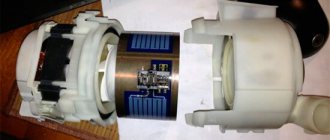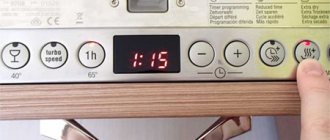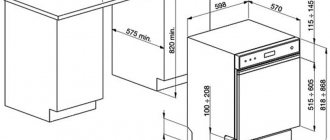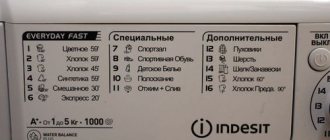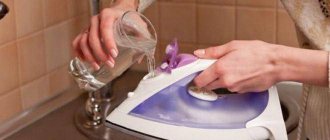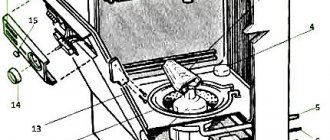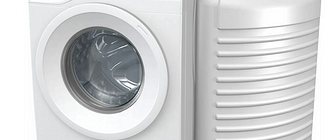What does it depend on?
If we consider the level of water consumption, according to this parameter there are 3 classes of PMM machines:
- highly economical;
- moderately economical;
- uneconomical.
For ease of understanding, each model is assigned an efficiency class, expressed in the form of letters - from “A” to “G”.
In the model range of well-known manufacturers, for example, Bosch, Candy, Electrolux, there are only highly economical PMMs, the classes of which are A - C. Uneconomical equipment is no longer produced in the EU countries, and their import is prohibited.
There is no specific standard for how much water and light a dishwasher requires.
What does consumption depend on:
- design features of the equipment;
- additional functions.
Conventionally, there are 3 classes of devices:
- household (both full-size and narrow) – 9 – 14 l;
- compact – 6.5 – 10 l;
- professional (as a rule, installed in public catering outlets with large throughput) – 20 – 25 liters.
Figures shown may vary depending on model. For example, there are dishwashers with a “half load” option, which reduces water consumption by 20 - 30%.
Another, no less useful function is “intelligent assessment”, when the equipment independently determines the required amount of liquid without compromising quality. As a rule, such functionality is inherent in premium models.
How many resources does a dishwasher use?
How much volume the PMM uses in one wash depends on the type, class, and load. The manufacturer indicates this data in the technical specifications. So:
- Compact models hold 6-8 sets of dishes. Approximately 7-10 liters are taken per cycle.
- Full-size and narrow appliances with a capacity of 10 to 14 sets consume from 9 to 14 liters.
- Professional dishwashers, which are used in catering establishments, use up to 25 liters.
The equipment is selected taking into account the number of people. Do you have a small family? Buy a compact version, otherwise you will have to save up dirty plates for a long time to fully load.
Note! Modern brands - Bosch, Siemens, Milli - have a half-load function. At the same time, resource consumption is reduced by half.
In some models, the consumed displacement is more than indicated in the instructions.
How much H2O is lost in one wash?
Water consumption directly depends on the capacity of the device.
Regular (narrow, full-size)
These are middle-class machines, where a narrow one can wash 9 sets of dishes in 1 cycle, and a full-size one can wash 10-14.
The average consumption for such equipment ranges from 9 to 14 liters . In this case, we are talking about cold water, since PMMs are often connected to cold water supply in order to save resources. That is, to wash 9 sets of dishes, the machine needs only 9 liters of water - this is quite economical.
The peculiarity is how this technique works. The PMM collects water once and uses it to wash dishes. In this case, the water passes through the cleaning filter during the cycle. Towards the end of the procedure, the technician again takes water to rinse the dishes and completes the cycle with a final rinse.
The cost-effectiveness of popular PMMs priced up to 40,000 rubles is presented in the table:
Economical
Dishwashers are produced that spend only 7 liters per cycle . Usually these are premium segment models or compact PMMs. Low water consumption does not always mean low capacity of equipment.
There are models with a large load but minimal consumption, but they are expensive. Example - Siemens SN 236100 ME, whose water consumption is 6.5 liters.
This is a full-size appliance, designed for 13 sets of dishes, with an energy consumption class of A++. As a rule, economical models require 40% less water than conventional ones.
Compact PMMs with a small capacity designed for 6 to 8 sets of dishes are also called economical. They consume the same amount of water as the narrow versions - 6.5 - 9 liters. It turns out that their level of water consumption is similar to large dishwashers, but they are capable of washing much less dishes.
Comparison with hand washing
When washing by hand, in order to wash the amount of dishes that would fit in the PMM, you will need 70 - 100 liters of water, both hot and cold.
That is, a machine with a flow rate of 7 - 14 liters requires 10 times less water.
Approximate calculation:
- Dishwasher. 14 l x 360 (days) = 5040 l (cold water);
- hand wash. 70 l x 360 = 25200 l (12000 – cold, 13200 – hot).
The price of 1 cubic meter of water depends on the region of residence. For example, a cold one costs 30 rubles, a hot one – 100.
It turns out:
- PMM. 5040 x 30 = 151.2 rubles;
- manual. 12 x 30 + 13.2 x 100 = 1680 rubles.
If you take into account water consumption, then a dishwasher is much more economical than washing by hand.
Does a dishwasher save water?
If you have meters in your apartment, you can compare how much water a machine uses per cycle and how much is used when washing appliances manually. At the same time, keep an eye on the cold water meter, because most PMMs are connected to a cold tap (read the article on connecting a dishwasher).
Hot water contains a large number of impurities. You will have to install an additional filter, as well as constantly mix it with a cold stream in order to achieve the optimal temperature.
To independently compare how much is spent during manual washing and when using equipment, consider: how many sets fit in your PMM.
Let's take, for example, 14 sets - that's 34 devices. According to the manufacturer, the narrow PMM uses 10 liters in one cycle. Whereas for washing tableware by hand, 43 liters were spent in this amount (the total consumption from the hot and cold tap is taken into account; the tap was turned off while soaping the plates). The savings are obvious.
Why does this happen? The secret to saving lies in the operating principle of the PMM. Many Bosch brand models, for example, are equipped with a water flow sensor. It is passed through a filter and can be used several times. In addition, the nozzles release jets under high pressure, which allows you to effectively wash devices without wasting much money. Thanks to electronic control, the sensor will not allow you to use more than necessary.
Are there savings or not? In one year of using the equipment, 8280 liters of water are consumed, which is beneficial, even taking into account the economical consumption of resources during manual washing. If you spend more than 100 per day, then the savings will be even greater.
Benefits of using a dishwasher
During operation of the equipment, only cold water is consumed, the tariffs for which are much lower. Each device is equipped with a heating element for heating.
Users will notice that cleaning also requires electricity and detergent powders. All this applies to manual care, and there is much more free time.
You found out how many liters a dishwasher takes and whether it allows you to save money. When choosing, pay attention to the class of the model; calculations must be carried out individually. But keep in mind the indisputable fact - this is a significant time saving.
How much electricity does the PMM consume in 1 cycle?
The energy efficiency of working units and the technical solutions used by the manufacturer determine the cost-effectiveness of the PMM.
A lot of light is spent on running the heating element , circulation pump and pump.
The heating element that heats the water consumes the most; in second place is the element that ensures the drying operation. In machines without hot drying, the consumption is lower.
There are dishwashers with convection drying. They do not have a second heating element or fan, which reduces energy consumption by 40%.
For the most part, light consumption depends on the capacity of the tank containing water and its temperature. That is, a smaller tank means lower energy consumption.
Before buying a PMM, it is worth studying its energy efficiency in advance, which is indicated in the technical data sheet.
This is a line called “energy class”, where a specific letter is indicated:
- A – 0.7 – 1.7 kW;
- B – 1.08 – 1.1 kW;
- C – no more than 1.5 kW;
- D, E (nowadays they are becoming less common) – up to 2 kW;
- F, G (non-economical models) – 2.5 – 2.7 kW.
If the manufacturer was able to achieve a value below 0.7 kW, then a “+” sign is added to the figure.
Shower
Another part of our daily life is taking a shower. Some people claim that showering requires much less water than taking a bath - but this is another common misconception. Of course, water consumption depends on how much time a person spends in the bathroom, but again, it is difficult to imagine anyone taking a shower for less than five minutes. And taking into account the fact that these water procedures consume about 20 liters per minute, we can come to the conclusion that about 100 liters of water are spent on taking a five-minute shower. This kind of expense doesn’t look particularly economical, does it? And the fact that most of us spend more than five minutes in the shower makes it one of the most costly activities in terms of water consumption. No more economical than taking a bath.
Top 3 economical models
Let's consider models that allow you to save water and energy resources.
Beko DTC 36610 W
Freestanding compact model with touch controls. It can wash up to 6 sets of dishes, and consumes 6.5 liters of water per cycle . Energy efficiency class – A+.
The manufacturer has increased the safety of the equipment by installing the “WaterSafe+” system - blocking the water supply in the event of a leak.
There are all the necessary programs, for example, quick washing, working with glass, economical mode (water is heated to a temperature of +50 degrees).
The informative display will show how much time is left until the end of the cycle and display the amount of salt for washing. The only negative is that due to its compact size, the maximum number of sets of dishes is no more than 6 (for a large family this may seem small). The current price can be viewed here.
Bosch SPS 25CI07 E
Compared to the previous version, the larger and more spacious model is capable of washing 9 sets of dishes in 1 cycle , consuming the same amount of water.
This PMM is narrow, so it will not take up much free space. The GlassProtect system allows you to wash even fragile glass utensils.
The “ActiveWater” function and the loading sensor are responsible for efficiency - the machine itself will determine how much water and light it needs. Additionally, the half-load option speaks in favor of efficiency. You can program the operation of the machine in advance by setting a timer.
The cost of the machine is from 35,000 rubles.
Siemens SN 636X03 ME
Full-size equipment, protected from leaks.
Number of programs – 6. Energy consumption class – A++ (0.93 kW/h), water consumption – 9.5 l . In 1 cycle the machine can wash 14 sets of dishes.
The model can safely be called economical, since there is a half-load option and an eco mode (lowering the water temperature for not too dirty dishes). The cost of the device is from 38,000 rubles.
PMM can easily cope with heavily soiled items, for which it pre-rinses them.
Washing dishes
Washing dishes is not the most expensive process in terms of water consumption. But if you wash dishes without thinking about saving money, it can easily waste up to 50 liters every time you decide to clean the kitchen. In five minutes, about 50 liters of water flows through an open tap. Needless to say, it is unreasonable to turn on a half-empty or sometimes completely empty dishwasher for the sake of washing one dish, because each cycle of its operation uses the same amount of water as with a full load.
Does the device save resources?
Savings make sense if meters are installed for the H2O supply . Cost-effectiveness will be considered using the example of the Siemens SN 66M094 model, designed for 14 sets of dishes.
This is 63 items, including plates, cups, pots, cutting board and cutlery. She will wash them for 3 hours (intensive mode), and will take only 10 liters of water.
If you wash at least half of these 63 items, but by hand, you will need, on average, 20 minutes and 43 liters of water (hot and cold). In terms of liquid resources, the savings are obvious.
To evaluate the real savings, you should also take into account the costs of light and cleaning tablets. It turns out that electricity is wasted, but water is saved. In general, the costs for manual and machine washing are approximately the same.
Hand washing dishes - how much water do we use?
In order to understand how much water is lost when washing dishes by hand, you should first pay attention to how exactly the housewife washes the dishes. The most “generous” method is to wash dishes under running water. This results in a very high consumption of water and detergent, since the sponge has to be dipped into the gel every now and then.
Since most of the water (approximately 60 - 70%) flows away just like that, and the tap does not close for half an hour, at least 150 - 200 liters of clean water will go down the drain. This is at a cost of hot water of 120 rubles or more!
Even if a housewife fills the sink with water and washes dishes in it, she will save some water, but the quality of the wash will decrease. Which is not a priority criterion for saving.
Cost Feedback from Consumers
Users note that dishwashers are convenient for washing large dishes and kitchen utensils.
The main thing that users note is saving time , not water.
Yes, there are inconveniences associated with the need to “accumulate” dirty dishes before putting them in the washing machine.
For this reason, buying an appliance for an apartment is questionable for those people who have, for example, 2 cups and 2 plates in circulation; it is easier for them to wash the dishes by hand. But, the equipment will be a godsend for large families who like to gather with guests.
As for saving electricity, you can program your dishwasher using a timer to run at night when a reduced rate is in effect.
There is another opinion regarding the price of service. We are talking about special tablets for washing dishes. Branded consumables sometimes cost a fortune if the equipment is used frequently , but they are easily replaced with simpler and cheaper detergents.
In general, the main advantage of using a dishwasher, according to users, is saving time, the only irreplaceable resource.
Detailed reviews and discussion can be read here and here.
Machine washing mechanism - what is the secret to saving money?
In order to answer the question of saving water in a dishwasher, you first need to understand dishwashing technology. Immediately after loading the dishes and turning on the washing program, the machine immediately starts drawing water. In this case, the machine takes a strictly defined amount for the first stage of the washing mode - getting wet. The machine rinses the dishes for five minutes, simultaneously heating the water (if required by the mode).
After completing the first stage of washing, the machine can get some water to start the second stage - active washing of dishes. But at the same time, the machine continues to use the water that was used during rinsing. The fact is that when the machine passes water through the system, it filters it. And all dirt remains on the mesh at the bottom of the machine. Thus, the machine uses water most economically, cleaning it throughout the entire washing cycle.
During active washing, water is supplied to the dishes under high pressure, which helps to wash away all dirt in the most efficient manner, and the detergent dissolved in water disinfects the dishes and allows them to be cleaned until they shine.
As soon as the active washing stage is completed, the machine drains the water into the drain and collects new, clean water for rinsing. Thus, the highest quality of washing is achieved with the least amount of water and electrical energy. This result cannot be achieved by hand washing.
If you repeat all this manually, you will need a large amount of work space (it will take up the entire kitchen), a lot of time and many water tanks. All these advantages are contained in a small, compact dishwasher.
Are there savings?
Now let’s analyze, if the difference is in how much water a dishwasher spends and how much a person spends on washing the same amount of dishes, does the machine actually save water or not? You can only talk about saving water consumption if you have water meters; if you don’t have them, then the water consumption of the dishwasher doesn’t matter.
If we take, for example, a narrow Siemens SN 66M094 dishwasher with a capacity of 14 sets and load 63 items into it, for example:
- 18 plates,
- 14 cups,
- 2 pans,
- 3 salad bowls,
- 1 cutting board,
- 1 teapot,
- 24 cutlery,
then in about three hours with intensive mode it will spend 10 liters of water.
We tried to wash half of the set of dishes that the dishwasher washed, that is, 34 items. The whole process took 20 minutes. At the same time, the water was turned off when the dishes needed to be washed. As a result, 23 liters of hot and 20 liters of cold water were spent, a total of 43 liters. For just one wash, the figure seems impressive.
If we convert the savings from liters to rubles, this is what we got: for 1 year of daily operation of the machine, you can save 8280 liters, the average cost of hot water for 2021 in Moscow is 130 rubles. This means that the dishwasher saves 1,076 rubles in your budget on hot water. Savings on cold water will be 108 rubles.
Conclusion! A dishwasher will save 1,184 rubles on water per year. But this is subject to the economical use of water when washing by hand; there are those who spend 100 liters of water a day washing dishes, which means that the machine will save even more.
Of course, this is a small amount, and in order to talk about real savings, you also need to calculate the electricity consumption and the cost of detergents. As for electricity, water savings cover electricity consumption by about 3-4 times. There will be about 830 rubles left for detergents. This money may not be enough for a year, depending on what to wash and what to sprinkle, but we can say that the total costs of hand and machine washing are approximately equal. However, there is still a big advantage in favor of a dishwasher; it will save you time, which you can spend with pleasure.
Thus, even according to the most conservative estimates (with a water consumption of 14 liters), the dishwasher saves water. But whether your family budget saves or not, calculate for yourself. Everything will depend not so much on the model of the machine, but on what detergents you use to wash dishes. In our opinion, are these costs worth a few minutes of rest after work?

